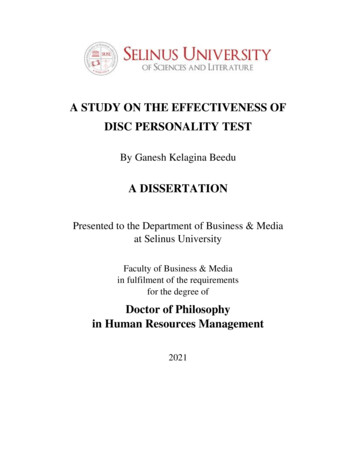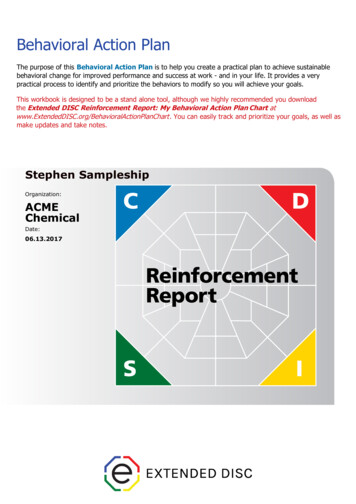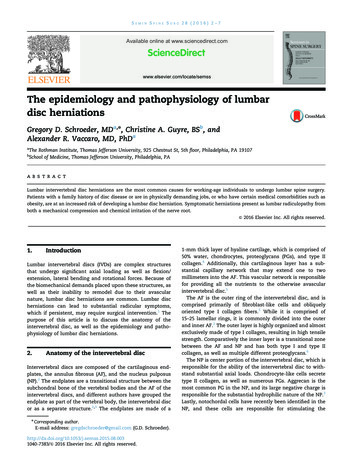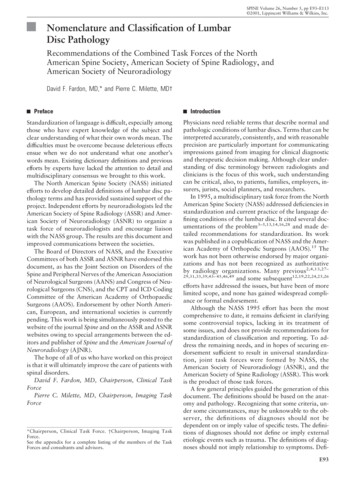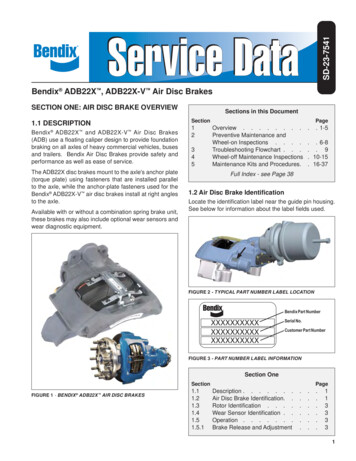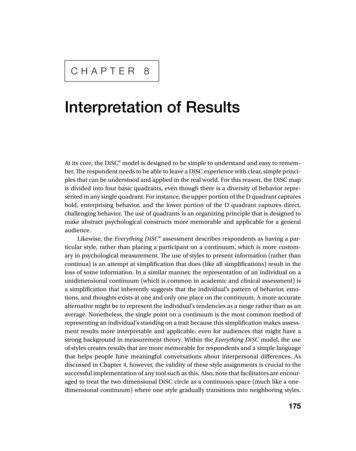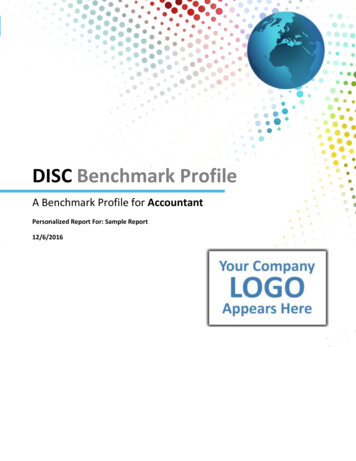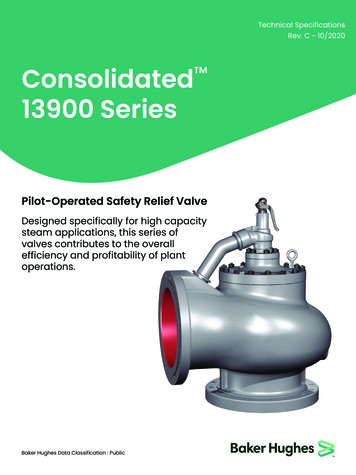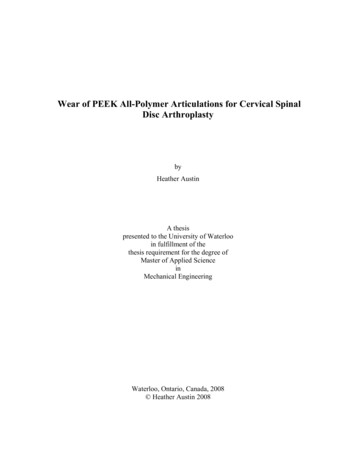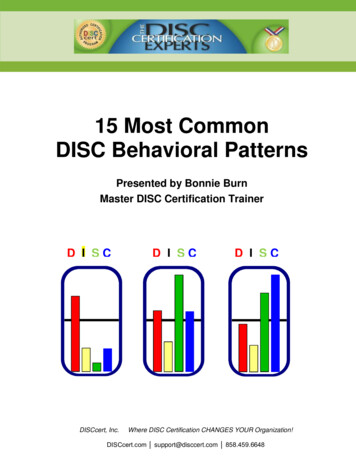
Transcription
15 Most CommonDISC Behavioral PatternsPresented by Bonnie BurnMaster DISC Certification TrainerD I SCDISCcert, Inc.D I SCD I SCWhere DISC Certification CHANGES YOUR Organization!DISCcert.com support@disccert.com 858.459.6648
Table of ContentsIntroduction to 15 Most Common Behavioral Patterns . Page 14 Single Style Behavioral PatternsD "Producer" . Page 2I "Networker" . Page 3S "Planner" . Page 4C "Fact Finder" . Page 511 Combination Style Behavioral PatternsDI "Dynamo" . Page 6Di "Results Driven" . Page 7DC "Explorer” . Page 8Id "Influencer" . Page 9IS "Coach" . Page 10IC "Assessor" . Page 11Sdc "Examiner" . Page 12Sd "Finisher" . Page 13SI "Harmonizer" . Page 14CS "Formalist" . Page 15CIs "Technician" . Page 16Page 0 of 18
Introduction to 15 Most Common Behavioral PatternsWhat follows are the 15 most common behavioral combinations (styles) that are found inthe modern workplace. The behaviors that are displayed to or observed by others are acombination of the influence of each of the four major factors. Typically, each style willhave one or two (most often) of the DISC factors that are prominently displayed by theindividual. Included is a description of the 15 Most Common Workplace Patterns alongwith some insights into how they typically function in the day to day interpersonaldynamics.You need to remember that the style is a baseline indicator that will be adapted bythe person based upon the interpersonal dynamic of the relationship. For example,how one displays his/her dominance or urgency will likely be different toward theboss than it would be toward a direct report.There are many more possible styles when combining the (4) four DISC behavioraldimensions. The (15) fifteen basic styles are naturally occurring groups that are useful forrepresenting the primary behavioral style or characteristics observed by others whenworking and interacting in more common work situations. Each style is carefullyconstructed by integrating all (4) four DISC behavioral dimensions into an integrated stylethat is easily identified by non-trained observers.Page 1 of 18
D the “PRODUCER”Style Overview:Producers follow their own path and will seek new projects and challenges. They are selfreliant and like to solve their issues without asking for help. This independence fostersinnovation that is strongly advocated to others. Being in control is important to them andthey can push back if challenged. They have high expectations of others and can be quitecritical if expected results lag. They can be seen as uncaring and, at times, difficult to workwith.Goals: Finding new opportunities and goals to achieve.Emotional Characteristics: Will strive to meet their own needs intheir own way.How others are valued: Based upon ability to create workablesolutions that meet the Developer's standards.Group Influence: Will influence by setting a competitive fast pacedagenda aimed at accomplishing results and by projecting personalpower.Value to the Organization: Will avoid the "blame game" and willoffer new and innovative solutions. Will get results."Watch Outs": Can appear over controlling of others andoutcomes in order to support and meet their own personalagendas.When Under Pressure: Can become isolated and will push backhard if they are challenged or threatened or if they are denied newopportunities.Fears: Losing control or being without meaningful challenges.Page 2 of 18
I the“NETWORKER”Style Overview:Networkers have many personal contacts who support their efforts. They are outgoing,socially comfortable and make friends with ease. They promote with enthusiasm and drawon their contacts to help them achieve their goals. They are quite optimistic, which can leadto misjudging others. They may not spend time on considering negative consequences oftheir "gut feel" inclinations. They can over-talk as they pursue their objectives.Goals: To gain approval, popularity and recognition.Emotional Characteristics: Very willing to accept and includeothers.How others are valued: Via others verbal skills.Group Influence: Via praise, opportunities and providing favors.Value to the Organization: Ideal for promoting ideas and projects."Watch Outs": Can overuse praise and be too optimistic.When Under Pressure: Can become even less detail focused,disorganized and may struggle to actually "get things done".Fears: Being viewed in a bad light that detracts from prestige andself-worth.Page 3 of 18
S the “PLANNER”Style Overview:Planners blend well with most others. Moderate behaviors with unobtrusive behavior definethis pattern. Will likely be considerate, helpful and patient. Will build a solid relationshipwith a limited number of associates. Most effective in specialized areas of expertise. Will bewell planned and consistent in performance. Does not like "fire drills." Will be good atcontributing to projects and activities.Goals: Consistency and retain the status quo with a minimum ofradical change.Emotional Characteristics: Will often find the cooperative middleway.How others are valued: Via quality of relationships anddemonstrated competency.Group Influence: Reliable and consistent performance that can becounted on.Value to the Organization: Good short-term planner with a steady,stable and consistent activity level."Watch Outs": Unlikely to take risks, will passively resist change.When Under Pressure: Likely to adapt to a power figure or groupdirection.Fears: Rapid changes and disorganized activities.Page 4 of 18
C the “FACT FINDER”Style Overview:Fact-finders have highly developed "quality control" and critical thinking ability. They favorlogic and facts but also possess intuitive abilities that they will meld with the facts.Preparation is essential prior to action. They may appear shy but can work with others whohave similar high-quality focus. They avoid confrontational situations and, because theyneed to "get it right," can delay decisions. If they make a mistake, they will likely researchadditional material to support their original choice.Goals: To control circumstances, outcomes and other people.Emotional Characteristics: May appear disinterested andrestrained.How others are valued: Other's ability to effectively use logic anddata.Group Influence: Via persistence, tenacity and steady focus.Value to the Organization: Gets the facts, reviews the findingsand brings analytical clarity to the project."Watch Outs": Subject to "analysis paralysis".When Under Pressure: Can become quite concerned for a goodoutcome.Fears: Other's erratic behavior or facing strong criticism or blame.Page 5 of 18
DI the “DYNAMO”Style Overview:Dynamos will make an attempt to adjust or modify the thoughts and actions of others. Theyare good at understanding how to steer others toward a predetermined result. They will setthe stage for the desired result before they verbalize that desire. Their strong persuasiveskills can elicit cooperation from others but sometimes create a feeling by others of beingmanipulated. Dynamos can be intimidating and can seek to override the decisions ofothers.Goals: To control circumstances, outcomes and other people.Emotional Characteristics: May appear to not need attention oraffirmation from others.How others are valued: How they project their personal power.Group Influence: Via charm or intimidation and sometimes byoffering incentives and rewards.Value to the Organization: Will be a mover and shaker.Innovative, demanding, and will expect disciplined results."Watch Outs": Understand that the ends do not always justify themeans.When Under Pressure: Can be seen as manipulativeargumentative and abrasiveFears: Being seen taken advantage of or losing social status in thegroup.Page 6 of 18
Di the “RESULTS DRIVEN”Style Overview:The Results-Driven style displays strong self-confidence that may be viewed as arrogance.They will pursue options that challenge them to achieve goals. They like difficult tasks,unique opportunities and seek positions of authority. They avoid constraints. Rules can beviewed as loose guidelines. They act quickly and can become impatient and critical withmore methodical and analytical people. In the extreme, they can appear cool and abrasiveto others.Goals: Winning, achieving dominance and lack of restraint.Emotional Characteristics: High ego strength & conceptdevelopmentHow others are valued: Via ability to accomplish tasks quickly.Group Influence: Power of assertion and persistence to win.Value to the Organization: "Will get results"."Watch Outs": Can become too impatient and seek the "I win You lose" scenario.When Under Pressure: Critical and fault finding, can overstepbounds and not contribute fully to the team direction if different thantheir own.Fears: That other will take advantage, appearing tooaccommodating or too slow to act.Page 7 of 18
DC the “EXPLORER”Style Overview:Explorers display opposing directions in their behaviors. There is a desire for results andgoal achievement AND a competing desire for those results to be perfect. Explorers shiftbetween aggression and sensitivity, the desire for immediate results vs. consideration ofalternatives. They often make routine decisions quickly but may need to exercise cautionfor bigger ones. They are change agents who will want the space and flexibility to exploreby retesting and revisiting their conclusions over time. They can be seen as emotionallydistant and sometimes surprisingly direct.Goals: Achieving dominance and reaching unique goals.Emotional Characteristics: Can be either aggressive orrestrained.How others are valued: Do others meet their standards? Canothers present unique ideas that are effective and accurate?Group Influence: Will create effective structure and focus onreaching the group objectives and goals.Value to the Organization: Will initiate or adjust tactics and plans."Watch Outs": Can become overly critical and even blunt withothers.When Under Pressure: Can become bored with routine tasks. Donot respond well to micro management. Can become dominant &trail blazing.Fears: Need to be influential; will struggle with poor performance.Page 8 of 18
Id the “INFLUENCER”Style Overview:Influencers enjoy working with others. They are viewed as friendly, even as they seek toaccomplish their personal goals. They often gain the respect and support of others. Theyaspire to positions of authority and it is important that they "look good to others." They likevariety in their day. They can be too optimistic about others and tend to believe they caninfluence others more than they likely can. Influencers often needs analytical support tooffset their tendency to proceed without all the facts.Goals: Seek authority and prestige through a variety of statussymbols.Emotional Characteristics: Will be vibrant, enthusiastic andtrusting.How others are valued: Via the ability to verbalize andcompromise.Group Influence: Via friendliness, fluency and relationships.Value to the Organization: Often good at sales, being poised andconfident and is able to delegate to others."Watch Outs": Overselling, over enthusiastic, too optimistic.When Under Pressure: Can become too persuadable, will want tolook good.Fears: Routine, boring activities and difficult, highly politicalpersonal relationships.Page 9 of 18
IS the “COACH”Style Overview:Coaches are adept at solving "people problems." They are seen as warm, empathetic andinsightful. They like to form extended personal relationships and often develop a reputationfor unobtrusive, contributory efforts when working with others. They can become too lenientwith marginal contributors and tend to be too mild when issuing corrections, directions andexpectations.Goals: Building personal relationships and networks of alliance.Emotional Characteristics: Wants to be seen as warm and openby others.How others are valued: Openness toward others and basicgoodnessGroup Influence: Via personal relationships and being open toothers’ ideas, problems and needs.Value to the Organization: Will bring stability to group efforts withpredictable actions and will possess good listening skills."Watch Outs": Can become too tolerant and may avoid neededconfrontations.When Under Pressure: Can become too accommodating, trustingand sharing too much with others.Fears: Having to pressure others or being seen as the source ofpain or problems by others.Page 10 of 18
IC the “ASSESSOR”Style Overview:Assessors apply creative focus to practical, workable concepts and make them doable.They display competitive and results-oriented interactions but engage others withpersuasion rather than through aggressive methods. They are good at explaining theirideas and the steps required to reach their goals. They are organized and often have a stepby step action plan to assure a good result. They can be quite verbal in stating theirdissatisfaction and in criticizing others who are not contributing.Goals: To Win and to win with style.Emotional Characteristics: Strong desire to look good to others.How others are valued: By their ability to instigate action andactivities.Group Influence: Strong presentation of their competitive ideasValue to the Organization: Good team players who work throughothers."Watch Outs": Can overstep bounds of authority andresponsibility.When Under Pressure: Can become overly critical and impatientwith others.Fears: Looking bad in the eyes of other people and/or not beingviewed as a winner.Page 11 of 18
Sdc the “EXAMINER”Style Overview:Examiners are steady, objective and analytical. They are successful due to their strongpersistence in pursuing their objectives. They can excel in complex and/or technicalprojects. They rely upon logic rather than emotion. They like working alone and do not feelthe need to engage or be involved with others. They can sometimes be viewed as lackingtact and/or warmth.Goals: To control circumstances, outcomes and other people.Emotional Characteristics: May appear disinterested andrestrained.How others are valued: Other's ability to effectively use logic anddata.Group Influence: Via persistence, tenacity and steady focus.Value to the Organization: Effective team contribution that isdetailed with the ability to work individually or with otherseffectively."Watch Outs": Can become undiplomatic and outspoken.When Under Pressure: Can hold a grudge & become noncommunicative.Fears: Too much interaction with lots of other people & their ideas.Page 12 of 18
Sd the “FINISHER”Style Overview:Finishers possess a strong sense of personal accountability and results orientation.They will likely demonstrate a keen interest in the quality of the work being done.Because Finishers have a high opinion for the quality of their own work, they can often eitherdo a task themselves or take back a delegated task so that It's done right.Finishers operate at a high efficiency and expect acknowledgement and rewards for theirefforts.Goals: Personal accomplishments & results. Goals can be pursuedat the expense of others.Emotional Characteristics: industrious, diligent, can displayfrustration.How others are valued: By the results others achieve.Group Influence: Will be responsible and accountable for ownactions.Value to Organization: Will establish and accomplish the goalsthey set for themselves."Watch Outs": May become too self-reliant and task oriented.When under pressure: May become frustrated and impatient withothers; communications can degrade, and the achiever maybecome more "hands on" rather than delegating/sharing activitiesto others.Fears: Competitors or acceptance of poor work product standards.Page 13 of 18
SI the “HARMONIZER”Style Overview :Harmonizers balance both interpersonal connections and goals/objectives. They aresupportive, make others feel included, and extend a hand of friendship. They tend to bewell organized and deliver effective results. Being service oriented, the Harmonizer style isquite good at taking on/helping with tasks that others may struggle with themselves. Theydo not like conflict and may avoid connections with assertive individuals.Goals: Being accepted and appreciated by others.Emotional Characteristics: responds to affection and praise,rejects aggressive behaviors by others.How others are valued: By other's willingness to include the agentin activities and processes.Group Influence: Offering friendship and a willingness to listen.Value to the Organization: Blends well with others, supportive andteam oriented."Watch Outs": Overuse of kindness and accommodation.When under pressure: Will rely upon information of call uponpersonal relationships to address the current issue.Fears: This style seeks to avoid conflict, anger and disharmony.Page 14 of 18
CS the “FORMALIST”Style Overview:Formalist rely upon procedure and structure in all aspects of life. They are detailed orientedand seek perfection. They need to know the expectations and the timetable for their work.They can get bogged down in detail and will not rush important decisions. They will take arisk if they have the facts to support it. They may be initially suspicious of personalcompliments, praise or flattery.Goals: To achieve stable and reliable accomplishments.Emotional Characteristics: Focus on doing things right, mayappear reserved and restrained.How others are valued: The ability to be precise and accurate.Group Influence: Via detailed and accurate input to team efforts.Value to the Organization: Will embrace and support high qualityand expected standards."Watch Outs": Rely too much on past procedures; can becomerule bound.When Under Pressure: May revert to too much diplomacy and tapdancing.Fears: Aggressive and demanding relationships and interactionsPage 15 of 18
CIs the “TECHNICIAN”Style Overview:Technicians will seek projects in their area(s) of expertise. They constantly challenge theirown work and results. They are likely knowledgeable in many areas. They are easy to workwith unless their expertise is challenged. They are quality oriented and expect strongresults from themselves and others. They can become critical of others if they achievepoor results. At times, they can become too insistent on doing things a "certain way."Goals: High expectations for their own growth and advancement.Emotional Characteristics: Need to be current and keep pacewith others.How others are valued: Via demonstrated self-discipline, positionand authority.Group Influence: Projecting confidence in ability to create,implement and expand the correct activities and actions.Value to the Organization: Skilled problem solvers and experts inidentifying solutions for their own area(s) of experience."Watch Outs": Over focus on personal goals and may expect toomuch from others.When Under Pressure: Can become inhibited and overly sensitiveto critical feedback.Fears: Being too predictable or being unrecognized for theircontributions.Page 16 of 18
There are many more possible styles when combining the (4) four DISC behavioral dimensions. The (15) fifteen basic styles are naturally occurring groups that are useful for representing the primary behavioral style or characteristics observed by others when working and interacting in more common work situations. Each style is carefully
